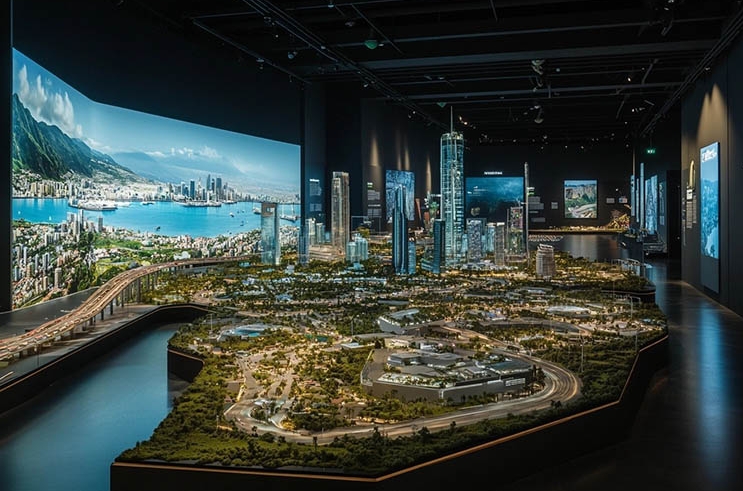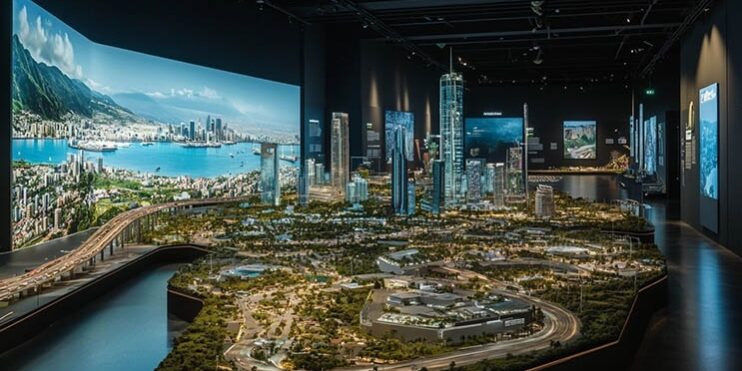Historical museums serve as cultural memory repositories, preserving civilization’s most precious codes across time and space. However, traditional exhibition models—characterized by one-way information delivery and static artifact displays—no longer satisfy contemporary audiences seeking deep engagement and emotional resonance. The question remains: How can we breathe new life into dusty historical narratives? How can we make the stories behind artifacts truly come alive?
The integration of immersive interactive design offers a groundbreaking solution for museum upgrades. Through innovative multimedia technology convergence, exhibition spaces transcend physical boundaries, transforming visitors from passive observers into active participants, explorers, and even co-creators of historical narratives. This approach achieves genuine multi-dimensional interaction between people, objects, environments, and emotions.
Reconstructing Historical Scenes Through Light and Shadow
Traditional museum exhibition logic often remains constrained by physical space limitations and unidirectional communication models. The introduction of multimedia interactive design, however, unlocks infinite possibilities for “reviving” historical scenes.

Dynamic Projection Technology
Advanced projection techniques serve as powerful tools for historical scene reconstruction. Dynamic lighting effects not only restore the grandeur of historical events but also create multi-layered narrative spaces through virtual-reality integration. Consider a war-themed exhibition area where:
- Wall projections display realistic battlefield scenes with drifting smoke
- Floor projections simultaneously simulate muddy trenches and ground tremors
- Surround sound effects complete the immersive atmosphere
This “all-encompassing visual language” breaks through the cold distance of glass display cases, transforming visitors from observers into historical “witnesses.”
Enhanced Diorama Applications
Upgraded diorama technology provides fresh perspectives for three-dimensional historical scene presentation. By combining giant hand-painted oil paintings with physical models and digital projections, dioramas evolve from static background panels into dynamic narrative platforms that shift with changing light and overlapping time-space elements.
Digital layers add dynamic effects and sound design, while physical models extend spatial depth. As visitors navigate these spaces, they trigger multiple sensory interactions, bringing historical scenes to life through virtual-reality integration and establishing a new paradigm for immersive historical education.
Interactive Installations Activate Exploration Instincts
Static exhibits with linear narratives often trap visitors in passive information absorption. The introduction of interactive sliding screen installations provides audiences with autonomous exploration pathways.
Sliding Rail Screen Technology
When visitors push sliding rail screens along exhibition routes, content automatically switches based on position changes. This progression moves from:
- Macro-historical timelines to micro-personal stories
- Object details to craftsmanship processes
- General overviews to specialized knowledge
This “surface-to-point narrative logic” maintains exhibition theme integrity while granting visitors personalized viewing freedom. The technology responds to individual interests, allowing for customized information depth selection.
Touchscreen Integration
Modern touchscreen interfaces embedded throughout exhibitions enable visitors to:
- Access multilingual content options
- Explore detailed artifact histories
- View 3D model reconstructions
- Participate in interactive quizzes and challenges
Technology-Enhanced Spatial Storytelling
Museum upgrades represent more than exhibition method iterations—they constitute fundamental reconstructions of spatial narrative logic. Through integrating projection mapping, motion-sensing interaction, and spatial audio fields, exhibition halls themselves become perceivable, interactive “super-media environments.”
Multi-Sensory Integration
Contemporary historical museums utilize immersive interactive design to:
- Break traditional exhibition boundaries
- Reconstruct historical contexts through digital lighting effects
- Activate exploratory behaviors via interactive installations
- Awaken cultural memories through virtual-reality fusion
Personalized Narrative Pathways
These cultural spaces integrate digital technology, dynamic interaction, and innovative exhibition design. Rooted in regional cultural foundations, they create individualized narrative routes and participatory experience designs that:
- Highlight local historical characteristics
- Establish multi-dimensional storytelling platforms for audience-civilization dialogue
- Generate emotional resonance across millennia through virtual-reality integration
Future-Forward Museum Design Principles
Visitor-Centric Approach
Modern museum design prioritizes visitor engagement over passive consumption. Key principles include:
- Interactive decision-making opportunities
- Multiple learning style accommodations
- Accessible design for diverse audiences
- Technology that enhances rather than dominates content
Cultural Authenticity Balance
While embracing technological innovation, successful museum upgrades maintain authentic cultural representation through:
- Careful historical accuracy verification
- Community stakeholder involvement
- Preservation of original artifact significance
- Respectful integration of traditional and modern elements
Sustainable Implementation
Long-term sustainability considerations encompass:
- Energy-efficient technology selections
- Maintenance-friendly system designs
- Staff training program development
- Budget-conscious upgrade planning
Measuring Success: Impact Assessment
Effective museum transformation requires comprehensive evaluation metrics:
Quantitative Indicators
- Visitor engagement duration increases
- Return visitor percentages
- Educational outcome assessments
- Technology interaction completion rates
Qualitative Feedback
- Visitor satisfaction surveys
- Educational impact testimonials
- Community cultural connection strength
- Long-term cultural preservation effectiveness
The future of historical museums lies in seamless technology-culture integration that respects the past while embracing innovative storytelling methods. Through thoughtful implementation of immersive interactive design, these institutions can fulfill their mission as dynamic cultural bridges, connecting contemporary audiences with their heritage through engaging, memorable, and meaningful experiences.
By transforming static exhibitions into living historical narratives, museums become vibrant community centers where the past, present, and future converge in powerful, educational encounters that inspire lifelong learning and cultural appreciation.







